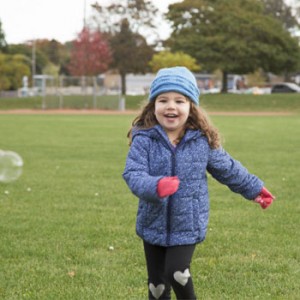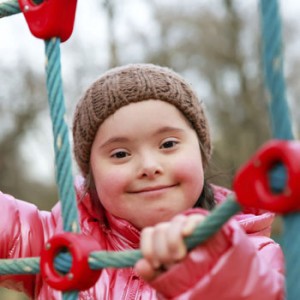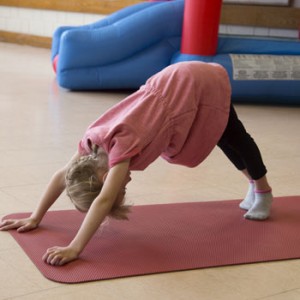Daily opportunities to be active
Children should be physically active each day as part of play, games, sports, active transportation, recreation and physical education. This includes outside activity that encourages children to explore a natural environment and take risks.
Physical activity should also take place with family, in childcare, in school, and in the community.
Here are ways that you can help children to meet their physical activity needs:
- Unstructured physical activity (also known as child-led activity or free play):
This is when children play freely on their own or with other children. The role of the adult is to watch or supervise at a level that is appropriate to the age and developmental stage of the child. Adults can join in with the child during unstructured physical activity but the adult is not leading the activity. - Structured physical activity (also known as adult-led activity or facilitated play):
This is when children participate in organized activities that are led by an adult. Examples include soccer practice, dance class or a volunteer-led after school activity.
It is important that children participate in all different types of activities to meet the Canadian 24-Hour Movement Guidelines.
Physical activity plays a big role in physical development and health, but did you know there are many other benefits of physical activity?
Physical Development
Physical activity:
- Helps a child grow
- Builds and maintains a healthy heart, lungs, bones, muscles and joints
- Fosters the development of motor skills including fundamental movement skills
- Gives energy during the day
- Helps a child sleep better at night
- Enhances flexibility
- Develops good posture
- Improves coordination and balance
- Helps achieve and maintain a healthy body weight
- Improves fitness levels
Emotional Development
Physical activity:
- Provides enjoyment and makes children feel happy
- Reduces anxiety and relieves stress
- Prevents, reduces, and helps manage depression
- Helps build confidence and positive self-esteem
- Improves the ability to deal with stress
Social Development
Physical activity:
- Provides opportunities to practice and develop social skills
- Encourages interactions with others
- Helps develop friendships
- Encourages healthy family engagement
- Teaches life skills
- Promotes leadership skills
- Develops confidence
- Helps nurture imagination and creativity
- Promotes positive behaviour
Cognitive Development
Physical activity:
- Enhances the development of brain function
- Improves problem-solving abilities
- Increases attention and concentration
- Improves memory
- Enhances creativity
- Increases readiness to learn
- Improves learning and academic performance
The path to a healthy lifestyle
Early physical activity also helps to establish healthy physical activity habits. By laying a strong foundation with fun and positive experiences, children will be more inclined to stay physically active as they get older. And if they stay active, they are more likely to live healthy, happy lives.
Source: Canadian Society for Exercise Physiology (CSEP). (2012). Canadian Physical Activity and Sedentary Behaviour Guidelines Handbook.
Source: ParticipACTION. (n.d.). Follow the Guidelines, Reap the Rewards.
Source: Timmons, B. W., LeBlanc, A. G., Carson, V., Connor Gorber, S., Dillman, C., Janssen, I., … & Tremblay, M. S. (2012). Systematic review of physical activity and health in the early years (aged 0–4 years). Applied Physiology, Nutrition, and Metabolism, 37(4), 773-792.
The International Physical Literacy Association defines physical literacy as “the motivation, confidence, physical competence, knowledge and understanding to value and take responsibility for engagement in physical activities for life.”
Physical literacy plays an interesting role in physical activity. Physical activity helps to develop physical literacy and in the long term, physical activity is promoted and enriched by physical literacy.
If children are physically literate, they have the ability to demonstrate a variety of movement skills with confidence and competence across a wide range of physical activities.
Fundamental movement skills
Fundamental movement skills are the building blocks of physical literacy. Just like literacy has the ABCs and numeracy has the 123s, physical literacy has smaller components that form the foundation for a lifetime of movement.
Fundamental movement skills fall into 3 general categories: body control, locomotion, and object manipulation.
Body control is being able to balance the body while stationary or while moving. Skills in this category include stretching, twisting, turning, pushing, pulling, swinging, and dodging.
Locomotion is being able to transport the body from one place to another. Basic skills in this category include crawling, walking, running, jumping, hopping, skipping, galloping, and sliding.
Object manipulation is being able to influence and control an object such as a ball. Basic skills in this category include the underhand throw, overhand throw, catching, kicking, striking, and volleying.
Confidence in movement
By developing fundamental movement skills and physical literacy, children develop the confidence to be physically active, whether through recreational games or competitive sports and activities.
Without physical literacy, research has shown that children tend to withdraw from physical activity and turn to more inactive and unhealthy choices during their leisure time.
Physical inactivity is associated with lower school grades, reduced confidence, lower self-esteem, poor social skills, and chronic health problems such as diabetes, high blood pressure, and certain cancers.
Encouraging physical literacy
Children develop physical literacy when they have lots of opportunities to play and experience different movement skills.
Both unstructured play, where children can explore on their own, and structured activities, where children receive formal instruction to improve their skills, develop physical literacy.
Here are some ways you can help children develop physical literacy:
- Try new activities and movement skills.
- Provide plenty of opportunities for practice.
- Be active in different places (on the ground, in the air, in the water and on snow/ice).
- Choose activities that suit your child’s skills and development.
Source: Canada’s Physical Literacy Consensus Statement. (2015).
Active outdoor play is an important component of physical activity for children. It involves providing opportunities for children to play outside, experiencing the elements, learning about their environment, and naturally exploring different types of movement such as running, jumping, climbing, and building without being prompted.
 Active outdoor play is often referred to as risky play. It is important to note that risky play does not mean dangerous play that is unsafe. Instead, it is giving children the freedom to evaluate challenges, test their own physical limits, and develop their confidence.
Active outdoor play is often referred to as risky play. It is important to note that risky play does not mean dangerous play that is unsafe. Instead, it is giving children the freedom to evaluate challenges, test their own physical limits, and develop their confidence.
Examples include climbing trees, digging in dirt, and jumping in puddles. These activities are thrilling and exciting to children and lead to curiosity, creativity, and problem solving.
Accordingly, don’t be afraid to encourage your children to explore outdoor and risky play. It will help them to understand their physical limits, manage challenges, and develop their self-confidence.
Source: 2015 Position statement on active outdoor play.
Research on Outdoor Play
According to the ParticipACTION Report Card on Physical Activity for Children and Youth (2015), when children are outside, they move more, sit less and play longer which leads to improved motor skill development and social skills, lower levels of obesity and increased overall physical activity. When children are outside, they are more active and take more steps than when indoors. For more information about active outdoor play, and its benefits, please read the Position Statement on Active Outdoor Play.
Source: ParticipACTION. (2015). The Biggest Risk is Keeping Kids Indoors. The 2015 ParticipACTION Report Card on Physical Activity for Children and Youth.
Loose parts is a term that was developed by architect Simon Nicholson in the 1970s. It represents a philosophy of play that is open-ended and encourages creativity, exploration and problem solving.
Loose parts are materials that can be manipulated in many different ways. They can be moved, carried, mixed together, sorted and assembled. They can be used alone or combined with other loose parts. There are no directions for loose parts play.
Loose parts play has positive connections to physical activity levels in children because they are constantly moving. Studies have shown that children who have access to loose parts materials, like those below, are more active than those who play on in a fixed play environment, like a playground.
Here are some examples of loose parts materials:
In a natural play area:
|
In a playground:
|
In an indoor environment:
|
Source: Pennsylvania State University. (2016). Loose Parts: What does this mean?
 We need to be active to be healthy. However, research is now showing us just how unhealthy it is to be sedentary.
We need to be active to be healthy. However, research is now showing us just how unhealthy it is to be sedentary.
Sedentary behaviour is sitting for long, continuous periods without moving. It’s unhealthy for anyone to be sedentary for long periods each day, but especially children.
Typical examples of children being sedentary are when they are:
- Sitting for long periods, like in a stroller or classroom
- Riding in a bus or car
- Watching television
- Playing video games
- Playing on computers, tablets and phones
Sedentary is more than just being inactive
It is important to note that sedentary behaviour is not exactly the same as physical inactivity. Children can be physically active, but still be considered sedentary if they spend their remaining waking hours being inactive.
For example, a 5 year old may play soccer for an hour after school each day, but would still be considered sedentary for a large portion of their day if he or she sits most of the day at school and then in front of the television at home for a large portion of the evening.
Sedentary behaviour has been directly linked to numerous physical and mental health problems. The good news? These can be avoided or reduced with regular physical activity and movement throughout the day.
Source: Canadian Society for Exercise Physiology (CSEP). (2012). Canadian Physical Activity and Sedentary Behaviour Guidelines Handbook.
Sitting for long periods of time is not healthy.
Sedentary behaviour and inactivity increase the odds for a child to develop chronic illnesses such as heart disease, type-2 diabetes, and some forms of cancer, along with mental health problems.
For most children, excessive screen time is the main cause of sedentary behaviour. This includes TV, computers, video games, tablets and smartphones. It makes no difference if children are viewing educational content or playing learning games, it is still screen time, and it still counts as sedentary behaviour.
Impacts on health and development
Excessive screen time has been linked to:
- Obesity – the more television a child watches, the greater his or her risk is of becoming overweight.
- Irregular sleep – the more television children watch, the more likely they are to have trouble falling asleep or to have an irregular sleep schedule. Sleep loss, in turn, can lead to fatigue which also leads to decreased physical activity.
- Behavioural problems – children who spend more than two hours a day watching television or using a computer are more likely to have emotional, social, and attention problems.
- Less time for play – excessive screen time leaves less time for active, creative play.
- Impacts to brain structure and functioning – excessive screen time changes the areas of the brain responsible for emotional processing, attention, decision making, and cognitive control.
Reducing the impacts and risks
To reduce the impacts and risks associated with sedentary behaviour, adults should make sure children have frequent activity breaks in their sedentary time. Here are some suggestions:
- Get children to stand up for activities where they would normally sit (e.g., arts and crafts).
- Set a timer and have children stretch every hour.
- Use energizers throughout the day such as short active games or active songs.
These activities will decrease sedentary time, help children to burn off excess energy and help with focus and concentration.
Mayo Clinic. (2016). Children and TV: Limiting you child’s screen time.
The Canadian Society for Exercise Physiology has released 24-Hour Movement Guidelines for the Early Years that combine physical activity, sedentary behaviour sleep. They show the interrelationship between all three behaviours.
For infants (less than 1 year), a healthy 24 hours includes:
- Being physically active several times daily in a variety of ways, particularly through interactive floor-based play. For those not yet mobile, this includes at least 30 minutes of tummy time spread throughout the day while awake.
- 14 to 17 hours (for those aged 0-3 months) or 12 to 16 hours (for those aged 4-11 months) of good-quality sleep, including naps.
- Not being restrained for more than 1 hour at a time (e.g., in a stroller or high chair). Screen
time is not recommended. When sedentary, engaging in pursuits such as reading and storytelling with a caregiver is encouraged.
For toddlers (1-2 years), a healthy 24 hours includes:
- At least 180 minutes spent in a variety of physical activities at any intensity, including energetic play, spread throughout the day—more is better.
- 11 to 14 hours of good-quality sleep, including naps, with consistent bedtimes and wake-up times.
- Not being restrained for more than 1 hour at a time (e.g., in a stroller or high chair) or sitting for extended periods. For those younger than 2 years, sedentary screen time is not recommended. For
those aged 2 years, sedentary screen time should be no more than 1 hour—less is better. When sedentary, engaging in pursuits such as reading and storytelling with a caregiver is encouraged.
For preschoolers (3-4 years), a healthy 24 hours includes:
- At least 180 minutes spent in a variety of physical activities spread throughout the day, of which at least 60 minutes is energetic play—more is better.
- 10 to 13 hours of good-quality sleep, which may include a nap, with consistent bedtimes and wake-up times.
- Not being restrained for more than 1 hour at a time (e.g., in a stroller or car seat) or sitting for extended periods. Sedentary screen time should be no more than 1 hour—less is better. When sedentary, engaging in pursuits such as reading and storytelling with a caregiver is encouraged.
Replacing time restrained or sedentary screen time with additional energetic play, and trading indoor for outdoor time, while preserving sufficient sleep, can provide greater health benefits.
For more information on the Guidelines, visit csepguidelines.ca. For fun games and activities to get children moving, visit our Activities page.
Source: Canadian Society for Exercise Physiology (CSEP). (2017). Canadian 24-Hour Movement Guidelines for the Early Years (0-4).
The Canadian Society for Exercise Physiology has released 24-Hour Movement Guidelines for Children and Youth that combine physical activity, sedentary behaviour sleep. They show the interrelationship between all three behaviours.
For children and youth (5-17), a healthy 24 hours includes:
- An accumulation of at least 60 minutes per day of moderate to vigorous physical activity involving a variety of aerobic activities. Vigorous physical activities, and muscle and bone strengthening activities should each be incorporated at least 3 days per week.
- Several hours of a variety of structured and unstructured light physical activities.
- Uninterrupted 9 to 11 hours of sleep per night for those aged 5–13 years and 8 to 10
hours per night for those aged 14–17 years, with consistent bed and wake-up times. - No more than 2 hours per day of recreational screen time. Limited sitting for extended
periods.
Preserving sufficient sleep, trading indoor time for outdoor time, and replacing sedentary behaviours and light physical activity with additional moderate to vigorous physical activity can provide greater health benefits.
For more information on the Guidelines, visit csepguidelines.ca. For fun games and activities to get children moving, visit our Activities page.
Source: Canadian Society for Exercise Physiology (CSEP). (2016). 24-Hour Movement Guidelines for Children and Youth.



